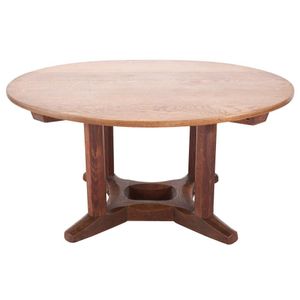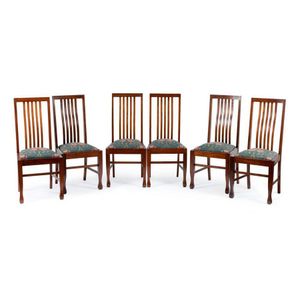William Morris (1834-96) was one of the key figures in the Arts and Crafts Movement.
The firm of Morris & Co. produced various types of furniture, mostly designed in collaboration with others and had an important influence in breaking with the over-ornate, vulgar and derivative traditions of the Victorian age.
The furniture was always very well made and always with an eye to beauty and originality of design, however plagiarized and hackneyed it may have become later on. But it was furniture intended for the machine age, and as Morris himself wrote: 'It is the allowing of machines to
more...
be our masters and not our servants that so injures the beauty of life nowadays'. Words that are equally as applicable today.
There are two types of chair known as a Morris chair both named after the design or influence of William Morris. The first is a reclining easy chair with upholstered seat and back and padded arms. The adjustable back fits into a series of grooves along the extended rear arms. In Australia the nearest equivalent would be the squatter's chair.
The second is a rush or cane seated cottage armchair, called a Sussex chair, usually made from ebonised or stained timber and which continued in popularity until the 1920s.
less...
William Morris (1834-1896) was an English designer, writer, and socialist activist who is widely regarded as one of the most important figures of the Arts and Crafts movement.
Morris was born in Walthamstow, Essex, to a wealthy family. He attended Oxford University, where he became interested in the works of John Ruskin, a prominent critic of industrialization and advocate for traditional craftsmanship. After graduating, Morris began a career in architecture, but soon shifted his focus to design, in 1861 founding the decorative arts company Morris, Marshall, Faulkner & Co. (renamed Morris & Co. in 1875).
At Morris & Co.
more...
, Morris designed and produced a wide range of decorative arts, including stained glass, wallpaper, and textiles, all of which were created using traditional craftsmanship techniques. He also designed furniture and other household objects, such as the iconic Morris chair.
In addition to his work as a designer, Morris was also a prolific writer and poet, and he played an important role in the Socialist League and other left-wing political organizations. He advocated for workers' rights and was a vocal critic of the negative impact of industrialization on the environment and society.
Morris continued to be active in the Arts and Crafts movement until his death in 1896. His legacy has been significant, as his work helped to inspire a renewed interest in traditional craftsmanship and design, and his writings and political activism continue to influence social and environmental movements today.
less...




 Loading more...
Loading more...